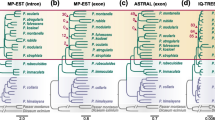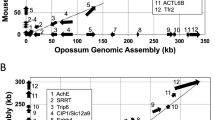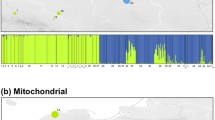Abstract
Recently, other researchers have found that closely related primate species had a lower male-to-female mutation rate ratio (α) than distantly related species. To determine if this is a general phenomenon affecting other mammalian orders, eleven species or subspecies of the rodent genus Mus and two outgroup species were compared. Intron sequences from a gene in the nonrecombining region of the Y chromosome Jarid1d (Smcy) and its X chromosomal gametolog, Jarid1c (Smcx), were analyzed in a phylogenetic context. The male-to-female mutation rate ratio for all thirteen taxa is approximately 2.5, which is similar to previous estimates in more distantly related rodents. However, when branches with lengths of more than 2.5% were removed from the analysis, the male-to-female mutation rate ratio dropped to 0.9. Thus, in closely related rodents, as in closely related primates, the male-to-female mutation rate ratio is lower than expected.

Similar content being viewed by others
References
Adkins RM, Gelke EL, Rowe D, Honeycutt RL (2001) Molecular phylogeny and divergence time estimates for major rodent groups: evidence from multiple genes. Mol Biol Evol 18:777–791
Agulnik AI, Mitchell MJ, Lerner JL, Woods DR, Bishop CE (1994a) A mouse Y-chromosome gene encoded by a region essential for spermatogenesis and expression of male-specific minor histocompatibility antigens. Hum Mol Genet 3:873–878
Agulnik AI, Mitchell MJ, Mattei M-G, Borsani G, Avner PA, Lerner JL, Bishop CE (1994b) A novel X gene with a widely transcribed Y-linked homologue escapes X-inactivation in mouse and human. Hum Mol Genet 3:879–884
Agulnik AI, Bishop CE, Lerner JL, Agulnik SI, Solovyev VV (1997) Analysis of mutation rates in the SMCY/SMCX genes shows that mammalian evolution is male-driven. Mamm Genome 8:134–138
Axelsson E, Smith NGC, Sundstrom H, Berlin S, Ellegren H (2004) Male-biased mutation rate and divergence in autosomal, Z-linked and W-linked introns of chicken and turkey. Mol Biol Evol 21:1538–1547
Bartosch-Harlid A, Berlin S, Smith NGC, Moller AP, Ellegren H (2003) Life history and the male mutation bias. Evolution 57:2398–2406
Birdsell JA (2002) Integrating genomics, bioinformatics, and classical genetics to study the effects of recombination on genome evolution. Mol Biol Evol 19:1181–1197
Bohossian HB, Skaletsky H, Page DC (2000) Unexpectedly similar rates of nucleotide substitution found in male and female hominids. Nature 406:622–625
Bohr VA, Philip DH, Hanawalt PC (1987) Heterogeneous DNA damage and repair in the mammalian genome. Cancer Res 47:6426–6436
Boursot P, Din W, Anand R, Darviche D, Dod B, Deimling FV, Talwar GP, Bonhomme F (1996) Origin and radiation of the house mouse: mitochondrial DNA phylogeny. J Evol Biol 9:391–415
Carmichael AN, Fridolfsson AK, Halverson J, Ellegren H (2000) Male-biased mutation rates revealed from Z and W chromosome-linked ATP synthase alpha-subunit (ATP5A1) sequences in birds. J Mol Evol 50:443–7
Catzeflis FM, Denys C (1992) The African Nannomys (Muridae): an early offshoot from the Mus lineage. Evidence from scnDNA hybridization experiments and compared morphology. Isr J Zool 38:219–231
Chamary J-V, Hurst LD (2004) Similar rates but different modes of sequence evolution in introns and at exonic silent sites in rodents: evidence for selectively driven codon usage. Mol Biol Evol 21:1014–1023
Chang BH, Li WH (1995) Estimating the intensity of male-driven evolution in rodents by using X-linked and Y-linked Ube 1 genes and pseudogenes. J Mol Evol 40:70–77
Chang BH, Shimmin LC, Shyue SK, Hewett-Emmett D, Li WH (1994) Weak male-driven molecular evolution in rodents. Proc Natl Acad Sci USA 91:827–831
Chang BH-J, Hewett-Emmett D, Li W-H (1996) Male-to-female ratios of mutation rate in higher primates estimated from intron sequences, Zool Stud 35:36–48
Charlesworth B, Charlesworth D (2000) The degeneration of Y chromosomes. Philos Trans R Soc Lond B Biol Sci 355:1563–1572
Chevret P, Granjon L, Duplantier JM, Denys C, Catzeflis FM (1994) Molecular phylogeny of the Praomys complex (Rodentia, Murinae) - a study based on DNA/DNA hybridization experiments. Zool J Linn Soc 112:425–442
Chevret P, Veyrunes F, Britton-Davidian J (2005) Molecular phylogeny of the genus Mus (Rodentia:Murinae) based on mitochondrial and nuclear data. Biol J Linn Soc 84:417–427
Ebersberger I, Metzler D, Schwarz C, Paabo S (2002) Genomewide comparison of DNA sequences between humans and chimpanzees. Am J Hum Genet 70:1490–1497
Ellegren H, Fridolfsson AK (1997) Male-driven evolution of DNA sequences in birds. Nat Genet 17:182–184
Ellegren H, Fridolfsson AK (2003) Sex-specific mutation rates in salmonid fish. J Mol Evol 56:458–463
Filatov DA (2004) A gradient of silent substitution rate in the human pseudoautosomal region. Mol Biol Evol 21:410–417
Filatov DA, Charlesworth D (2002) Substitution rates in the X- and Y-linked genes of the plants, Silene latifolia and S. dioica. Mol Biol Evol 19:898–907
Filatov DA, Gerrard DT (2003) High mutation rates in human and ape pseudoautosomal genes. Gene 317:67–77
Garcia-Moreno J, Mindell DP (2000) Rooting a phylogeny with homologous genes on opposite sex chromosomes (gametologs): a case study using avian CHD. Mol Biol Evol 17:1826–1832
Griffiths AJF, Miller JH, Suzuki DT, Lewontin RC, Gelbart WM (1996) An introduction to genetic analysis. W. H. Freeman and Company, New York
Haldane JBS (1947) The mutation rate of the gene for haemophilia, and its segregation ratios in males and females. Ann Eugen 13:262–271
Hellborg L, Ellegren H (2004) Low levels of nucleotide diversity in mammalian Y chromosomes. Mol Biol Evol 21:158–163
Hellmann I, Ebersberger I, Ptak SE, Paabo S, Przeworski M (2003) A neutral explanation for the correlation of diversity with recombination rates in humans. Am J Hum Genet 72:1527–1535
Huang W, Chang BHJ, Gu X, Hewett-Emmett D, Li WH (1997) Sex differences in mutation rate in higher primates estimated from AMG intron sequences. J Mol Evol 44:463–465
Hurst LD, Ellegren H (1998) Sex biases in the mutation rate. Trends Genet 14:446–452
Jansa SA, Weksler M (2004) Phylogeny of muroid rodents: relationships within and among major lineages as determined by IRBP gene sequences. Mol Phylogenet Evol 31:256–276
Johnson J, Canning J, Kaneko T, Pru JK, Tilly JL (2004) Germline stem cells and follicular renewal in the postnatal mammalian ovary. Nature 428:145–150
Jung A, Schuppe HC, Schill WB (2003) Are children of older fathers at risk for genetic disorders? Andrologia 35:191–199
Kahn NW, Quinn TW (1999) Male-driven evolution among Eoaves? A test of the replicative division hypothesis in a heterogametic female (ZW) system. J Mol Evol 49:750–759
Keightley PD, Johnson T (2004) MCALIGN: stochastic alignment of noncoding DNA sequences based on an evolutionary model of sequence evolution. Genome Res 14:442–450
Kimura M, Ohta T (1972) On the stochastic model for estimation of mutational distance between homologous proteins. J Mol Evol 2:87–90
Kumar S, Subramanian S (2002) Mutation rates in mammalian genomes. Proc Natl Acad Sci USA 99:803–808
Lercher MJ, Hurst LD (2002) Human SNP variability and mutation rate are higher in regions of high recombination. Trends Genet 18:337–340
Lercher MJ, Williams EJB, Hurst LD (2001) Local similarity in evolutionary rates extends over whole chromosomes in human-rodent and mouse-rat comparisons: implications for understanding the mechanistic basis of the male mutation bias. Mol Biol Evol 18:2032–2039
Li W-H (1977) Distribution of nucleotide differences between two randomly chosen cistrons in a finite population. Genetics 85:331–337
Li W-H, Yi S, Makova K (2002) Male-driven evolution, Curr Opin Genet Devel 12:650–656
Lundrigan BL, Jansa SA, Tucker PK (2002) Phylogenetic relationships in the genus Mus, based on maternally, paternally, and biparentally inherited characters. Syst Biol 51:410–431
Makova KD, Li WH (2002) Strong male-driven evolution of DNA sequences in humans and apes, Nature 416:624–626
Makova KD, Yang S, Chiaromonte F (2004) Insertions and deletions are male biased too: a whole-genome analysis in rodents. Genome Res 14:567–573
Malcom CM, Wyckoff GJ, Lahn BT (2003) Genie mutation rates in mammals: Local similarity, chromosomal heterogeneity, and X-versus-autosome disparity. Mol Biol Evol 20:1633–1641
McVean GT, Hurst LD (1997) Evidence for a selectively favourable reduction in the mutation rate of the X chromosome. Nature 386:388–392
Miyata T, Hayashida H, Kuma K, Mitsuyasu K, Yasunaga T (1987) Male-driven molecular evolution: a model and nucleotide sequence analysis. Cold Spring Harbor Symp Quant Biol 52:863–867
Nachman MW (1997) Patterns of DNA variability at X-linked loci in Mus domesticus. Genetics 147:1303–1316
Nei M, Kumar S (2000) Molecular evolution and phylogenetics. Oxford University Press, Oxford
Perry J, Ashworth A (1999) Evolutionary rate of a gene affected by chromosomal position. Curr Biol 9:987–989
Petes TD (2001) Meiotic recombination hot spots and cold spots. Nat Rev Genet 2:360–369
Sandstedt SA, Tucker PK (2004) Evolutionary strata on the mouse X chromosome correspond to strata on the human X chromosome. Genome Res 14:267–272
She JX, Bonhomme F, Boursot P, Thaler L, Catzeflis F (1990) Molecular phytogenies in the genus Mus: Comparative analysis of electrophoretic, scnDNA hybridization, and mtDNA RFLP data, Biol J Lim Soc 41:83–103
Shimmin LC, Chang BH, Li WH (1993) Male-driven evolution of DNA sequences. Nature 362:745–747
Slattery JP, O’Brien SJ (1998) Patterns of Y and X chromosome DNA sequence divergence during the Felidae radiation. Genetics 148:1245–1255
152:661–673
Swofford DL (2002) PAUP* Phylogenetic Analysis Using Parsimony (* and Other Methods). Sinauer Associates, Sunderland, Massachusetts
Tajima F, Nei M (1984) Estimation of evolutionary distance between nucleotide sequences. Mol Biol Evol 1:269–285
Thompson JD, Gibson TJ, Plewniak F, Jeanmougin F, Higgins DG (1997) The CLUSTAL X windows interface: flexible strategies for multiple sequence alignment aided by quality analysis tools. Nucleic Acids Res 25:4876–4888
Tremblay M, Vezina H (2000) New estimates of intergenerational time intervals for the calculation of age and origins of mutations. Am J Hum Genet 66:651–658
Tucker PK, Sandstedt SA, Lundrigan BL (2005) Phylogenetic relationships in the subgenus Mus (genus Mus, family Muridae, subfamily Murinae): examining gene trees and species trees. Biol J Linn Soc 84:653–662
Whittle CA, Johnston MO (2002) Male-driven evolution of mitochondrial and chloroplastidial DNA sequences in plants. Mol Biol Evol 19:938–949
Wolfe KH, Sharp PM, Li WH (1989) Mutation rates differ among regions of the mammalian genome. Nature 337:283–285
Yi S, Summers TJ, Pearson NM, Li W-H (2004) Recombination has little effect on the rate of sequence divergence in pseudoautosomal boundary 1 among humans and great apes. Genome Res 14:37–43
Zhang J (2004) Evolution of DMY, a newly emergent male sex-determination gene of medaka fish. Genetics 166:1887–1895
Acknowledgments
We thank James Crow for his comments on an earlier draft of this work. We also thank two anonymous reviewers for helpful comments. This work was supported by NIH EY12994 and NSF grant DEB9209950.
Author information
Authors and Affiliations
Corresponding author
Additional information
[Reviewing Editor: Dr. Deborah Charlesworth]
An erratum to this article is available athttp://dx.doi.org/10.1007/s00239-006-8279-y.
Rights and permissions
About this article
Cite this article
Sandstedt, S.A., Tucker, P.K. Male-Driven Evolution in Closely Related Species of the Mouse Genus Mus. J Mol Evol 61, 138–144 (2005). https://doi.org/10.1007/s00239-004-0279-1
Received:
Accepted:
Published:
Issue Date:
DOI: https://doi.org/10.1007/s00239-004-0279-1




